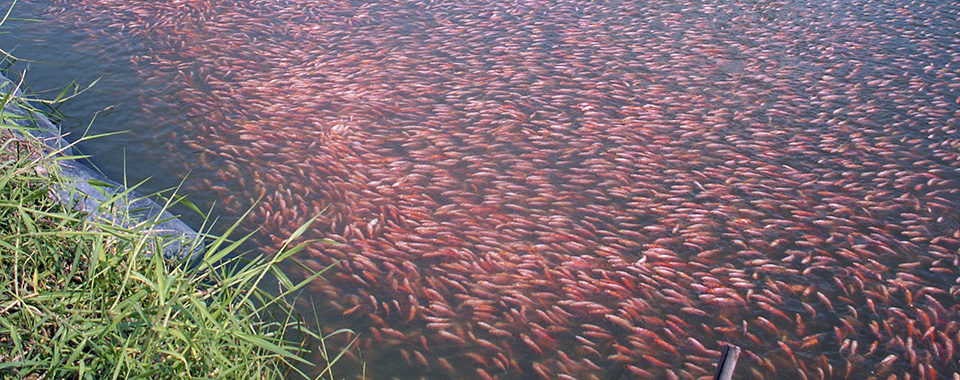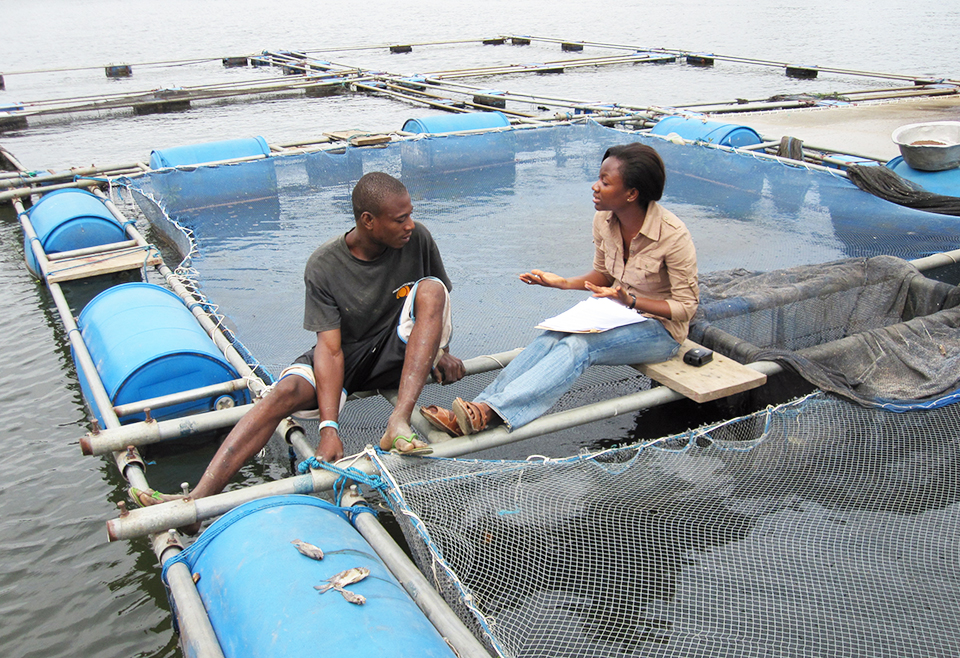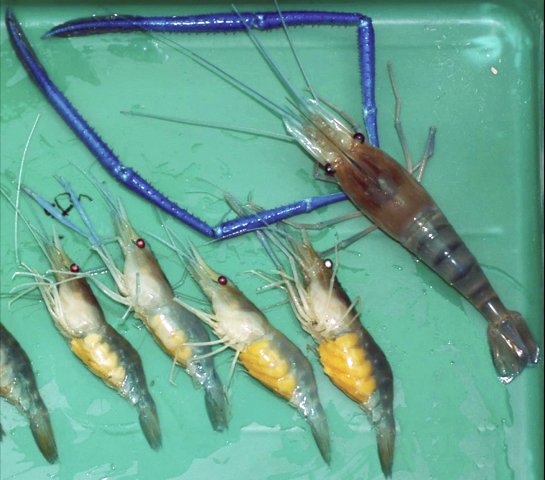Fry size and age uniformity, hormone-fishmeal mix result in high percentage of males

Tilapia have become an important, well-established seafood commodity. One of the reasons for their production boom is the successful development of technology that combines artificial egg incubation and monosex fry production using hormonal sex reversal.
Research and development
Expansion of tilapia farming on a commercial scale was hindered by the limited availability of quality fry realized by researchers. Attempts were made to develop a practical technique of mass-scale fry production at the Asian Institute of Technology (AIT) in Klong Luang, Pathumthani, Thailand. A series of on-station trials were conducted over a decade, maintaining the Chitralada strain of Nile tilapia broodstock in hapas installed in earthen ponds.
Breeding in hapas made the collection of eggs easier at early stages, which is needed to segregate them based on age. Uniformity in fry size and age in a given batch ensures that all the fry receive an adequate amount of hormone through feed, thereby resulting in a high percentage of males at the end.
The AIT method includes techniques of maintaining large number of broodfish in hapas in earthen ponds, egg collection at five- to seven-day intervals and artificial incubation of the collected eggs in a clean and controlled system. Feeding methyltestosterone hormone mixed with fishmeal at 60mg/kg for 21 days ensures over 99 percent males in the fry population.
Technology transfer
After the techniques proved successful, various attempts were made to transfer the technology to public and private sectors through contractual and other arrangements. Various institutions in the region were promoting aquaculture development in which tilapia production was a core focus. However, the main breakthrough in technology transfer occurred when a private hatchery in Thailand was successfully established. That, in turn, triggered the emergence of many others.
There are now about three dozen hatcheries in Thailand alone. Sales reports have shown that a single hatchery employing about 200 technical staff and field workers can produce up to 20 million fry per month. This success attracted the attention of many investors and helped spread the technology to Bangladesh, Brazil, Myanmar, Nepal, China, the Philippines, Vietnam and several other countries.
In addition to direct technology transfer, dissemination has been accelerated by the efforts of graduate students and short-term trainees as the tilapia-breeding techniques were incorporated into educational curriculums. Records show that over 100 post-graduate students carried out tilapia research as a part of the process, and about 1,000 officials were trained on tilapia alone and in combination with other species.
Industry expansion
In the past, tilapia were mostly cultured by small-scale farmers in rural areas in Thailand. Tilapia overtook catfish as the top species in total production after the mass-scale production package evolved in the mid-1990s. Considerable adaptations in the technology have been made in various parts of the world, which indicates that the ideas of many people have contributed to improving efficiency and widening distribution.
The rapid expansion of tilapia farming in many Asian countries has made it difficult for government and international organizations to keep accurate annual production data. For example, the United Nations Food and Agriculture Organization reports slightly over 200,000 metric tons (MT) for Thailand, which many people think is far underestimated.
While there is no accurate data-gathering mechanism in place, especially when so many fish are consumed by families at home and sold in local markets in rural areas, one of the ways to estimate production is based on the fry production data records maintained by the hatcheries.
Fry production records in Thailand using only the hormonal sex-reversal technique show about 1 billion per year. Assuming that an average farmer buys 40,000 tilapia fry for grow-out and a loss of 10 percent before stocking, 60 percent overall survival from stocking to final harvest and 250-gram average size of the tilapia consumed or sold, tilapia production can be estimated at about 160,000 MT. It is believed that almost the same amount is produced using mixed-sex fry and fry treated with other techniques.
The record for global fry production and supply using the hormonal sex-reversal technique is estimated at over 2.2 billion per year. By using the same assumptions above with this figure, total production of tilapia meat would exceed 500,000 MT, which is about one-fourth of the total tilapia production in the world. Assuming 35 percent flesh in the final product and that a person consumes 60 grams per meal twice a week, this volume would supply about 30 million people for a year.

Issues, recommendations
The efficiency of the AIT system has been questioned, because sometimes over half of the harvested eggs are lost during the whole process of artificial incubation, larval rearing, sex reversal and transfer from one place to another. Only skillful technical staff can minimize these losses, but there is a definite need to find easier ways to improve the efficiency of each stage of the production process.
It has been proved that no methyltestosterone used for sex reversal remains in the bodies of fish a week after receiving the last dose of the hormone in feed. Hormone residues can remain in pond water and sediments for up to a month. Although its presence quickly diminishes over time, the use of the hormone has become an issue for environmentalists in some countries.
Various researchers and organizations have been seeking alternative methods of effective sex reversal, but none of the alternatives have proven as effective as methyltestosterone. Nevertheless, any changes that minimize the amount of hormone used would be positive – and reduce costs, as well. One method tried by various researchers is soaking fry in hormone water for several consecutive days during the period sex determination takes place, the 11th to 14th days. However, no promising result has been shown so far.
Another issue is the ethyl alcohol used to dissolve hormone, which evaporates into the atmosphere. At the typical application rate of 240 mL per kg feed, a hatchery producing 5 million fry monthly uses about 300 L of alcohol every month. A simple drying machine that evaporates the alcohol and collects it for reuse would be a great help.
(Editor’s Note: This article was originally published in the September/October 2009 print edition of the Global Aquaculture Advocate.)
Now that you've reached the end of the article ...
… please consider supporting GSA’s mission to advance responsible seafood practices through education, advocacy and third-party assurances. The Advocate aims to document the evolution of responsible seafood practices and share the expansive knowledge of our vast network of contributors.
By becoming a Global Seafood Alliance member, you’re ensuring that all of the pre-competitive work we do through member benefits, resources and events can continue. Individual membership costs just $50 a year.
Not a GSA member? Join us.
Author
-
Ram C. Bhujel, Ph.D.
Aquaculture and Aquatic Resources Management Program
Asian Institute of Technology
P. O. Box 4, Klong Luang
Pathumthani 12120, Thailand[104,116,46,99,97,46,116,105,97,64,108,101,106,117,104,98]
Related Posts

Health & Welfare
10 paths to low productivity and profitability with tilapia in sub-Saharan Africa
Tilapia culture in sub-Saharan Africa suffers from low productivity and profitability. A comprehensive management approach is needed to address the root causes.

Health & Welfare
A look at tilapia aquaculture in Ghana
Aquaculture in Ghana has overcome its historic fits and starts and is helping to narrow the gap between domestic seafood production and consumption. Production is based on Nile tilapia.

Innovation & Investment
Monosex culture of prawns through temporal androgenic gene silencing
A newly developed technology for producing all-male populations of freshwater prawns by temporal silencing of the androgenic gland insulin-like gene marks the first RNA interference-based biotechnology to be commercialized in the field of aquaculture.

Health & Welfare
Potential of YY male tilapia technology
YY male tilapia technology, based on the genetic manipulation of sex, provides a robust, reliable method of achieving male fish. It avoids the use of hormones and maintains strain purity in genetically normal males.


